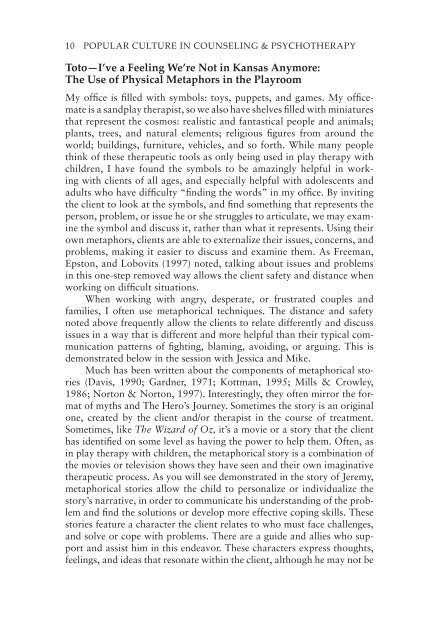Popular Culture in Counseling, Psychotherapy, and Play-Based ...
Popular Culture in Counseling, Psychotherapy, and Play-Based ...
Popular Culture in Counseling, Psychotherapy, and Play-Based ...
Create successful ePaper yourself
Turn your PDF publications into a flip-book with our unique Google optimized e-Paper software.
10 POPULAR CULTURE IN COUNSELING & PSYCHOTHERAPY<br />
Toto—I’ve a Feel<strong>in</strong>g We’re Not <strong>in</strong> Kansas Anymore:<br />
The Use of Physical Metaphors <strong>in</strong> the <strong>Play</strong>room<br />
My offi ce is fi lled with symbols: toys, puppets, <strong>and</strong> games. My offi cemate<br />
is a s<strong>and</strong>play therapist, so we also have shelves fi lled with m<strong>in</strong>iatures<br />
that represent the cosmos: realistic <strong>and</strong> fantastical people <strong>and</strong> animals;<br />
plants, trees, <strong>and</strong> natural elements; religious fi gures from around the<br />
world; build<strong>in</strong>gs, furniture, vehicles, <strong>and</strong> so forth. While many people<br />
th<strong>in</strong>k of these therapeutic tools as only be<strong>in</strong>g used <strong>in</strong> play therapy with<br />
children, I have found the symbols to be amaz<strong>in</strong>gly helpful <strong>in</strong> work<strong>in</strong>g<br />
with clients of all ages, <strong>and</strong> especially helpful with adolescents <strong>and</strong><br />
adults who have diffi culty “fi nd<strong>in</strong>g the words” <strong>in</strong> my offi ce. By <strong>in</strong>vit<strong>in</strong>g<br />
the client to look at the symbols, <strong>and</strong> fi nd someth<strong>in</strong>g that represents the<br />
person, problem, or issue he or she struggles to articulate, we may exam<strong>in</strong>e<br />
the symbol <strong>and</strong> discuss it, rather than what it represents. Us<strong>in</strong>g their<br />
own metaphors, clients are able to externalize their issues, concerns, <strong>and</strong><br />
problems, mak<strong>in</strong>g it easier to discuss <strong>and</strong> exam<strong>in</strong>e them. As Freeman,<br />
Epston, <strong>and</strong> Lobovits (1997) noted, talk<strong>in</strong>g about issues <strong>and</strong> problems<br />
<strong>in</strong> this one-step removed way allows the client safety <strong>and</strong> distance when<br />
work<strong>in</strong>g on diffi cult situations.<br />
When work<strong>in</strong>g with angry, desperate, or frustrated couples <strong>and</strong><br />
families, I often use metaphorical techniques. The distance <strong>and</strong> safety<br />
noted above frequently allow the clients to relate differently <strong>and</strong> discuss<br />
issues <strong>in</strong> a way that is different <strong>and</strong> more helpful than their typical communication<br />
patterns of fi ght<strong>in</strong>g, blam<strong>in</strong>g, avoid<strong>in</strong>g, or argu<strong>in</strong>g. This is<br />
demonstrated below <strong>in</strong> the session with Jessica <strong>and</strong> Mike.<br />
Much has been written about the components of metaphorical stories<br />
(Davis, 1990; Gardner, 1971; Kottman, 1995; Mills & Crowley,<br />
1986; Norton & Norton, 1997). Interest<strong>in</strong>gly, they often mirror the format<br />
of myths <strong>and</strong> The Hero’s Journey. Sometimes the story is an orig<strong>in</strong>al<br />
one, created by the client <strong>and</strong>/or therapist <strong>in</strong> the course of treatment.<br />
Sometimes, like The Wizard of Oz, it’s a movie or a story that the client<br />
has identifi ed on some level as hav<strong>in</strong>g the power to help them. Often, as<br />
<strong>in</strong> play therapy with children, the metaphorical story is a comb<strong>in</strong>ation of<br />
the movies or television shows they have seen <strong>and</strong> their own imag<strong>in</strong>ative<br />
therapeutic process. As you will see demonstrated <strong>in</strong> the story of Jeremy,<br />
metaphorical stories allow the child to personalize or <strong>in</strong>dividualize the<br />
story’s narrative, <strong>in</strong> order to communicate his underst<strong>and</strong><strong>in</strong>g of the problem<br />
<strong>and</strong> fi nd the solutions or develop more effective cop<strong>in</strong>g skills. These<br />
stories feature a character the client relates to who must face challenges,<br />
<strong>and</strong> solve or cope with problems. There are a guide <strong>and</strong> allies who support<br />
<strong>and</strong> assist him <strong>in</strong> this endeavor. These characters express thoughts,<br />
feel<strong>in</strong>gs, <strong>and</strong> ideas that resonate with<strong>in</strong> the client, although he may not be

















